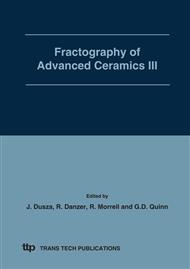[1]
V.G. Gryaznov and L.I. Trusov: Progr. Mater. Sci. Vol. 37 No. 4 (1993), p.289.
Google Scholar
[2]
G.E. Fougere, J.R. Weertman and R.W. Siegel: Scripta Met. Vol. 6 (1992), p.1879.
Google Scholar
[3]
N.G. Nieh and J. Wadsworth: Scripta Met. Mater. Vol. 25 (1991), p.955.
Google Scholar
[4]
C.W. Su, B.W. Chua, L. Lu and M.O. Lai: Mater. Sci. Eng. A. Vol. 402 (2005), p.163.
Google Scholar
[5]
K. Kumar et al.: Acta Mater. Vol. 51 (2003).
Google Scholar
[6]
T. Christman: Scripta Met. Mater. Vol. 28 (1993), p.1495.
Google Scholar
[7]
S.A. Firstov, T.G. Rogul et al., in: NATO ARW -Materials with high strength‖, Kiev, 2003, Kluver Publisher (2004), p.341.
Google Scholar
[8]
S.A. Firstov, T.G. Rogul et al.: Problems of Materials Science (Voprosi materialovedenia), (2003), 1(33), p.201.
Google Scholar
[9]
A.W. Thompson: Metal . Trans. Vol. 8A, 6 (1977), p.833.
Google Scholar
[10]
S.A. Firstov, N.V. Grajvoronsky and G.F. Sarzhan: Met. Phys. Adv. Tech. Vol. 17 (1998), p.105.
Google Scholar
[11]
S. Veprek, S. Reiprich and L. Shizhi: Appl. Phys. Lett. Vol. 66 (20) (1995), p.2640.
Google Scholar
[12]
S. Veprek and S. Reiprich: Thin Solid Films Vol. 268 (1995), p.64.
Google Scholar
[13]
L.J. Gibson and M.F. Ashby: Cellular solids: Structure & properties, Oxford: Pergamon Press, ISBN: 0-08-036607-4, (1988).
DOI: 10.1002/adv.1989.060090207
Google Scholar
[14]
R.Z. Valiev and I.V. Alexandrov: Nanostructured Materials produced by Severe Plastic Deformation (in Russian), Moskow, Logos, RF, 272, (2000).
Google Scholar
[15]
Y-T Cheng and Ch-M Cheng: Appl. Phys. Lett. Vol. 73, No. 5 (1998), p.614.
Google Scholar
[16]
W.C. Oliver and G.M. Pharr: J. Mater. Res. Vol. 7, No. 6 (1992), p.1564.
Google Scholar
[17]
S.A. Firstov and T.G. Rogul (in Russian), Reports of the National Academy of Sciences of Ukraine (Dopovidi NANU), № 4, (2007), p.110.
Google Scholar
[18]
J. Hirth and I. Lothe: Theory of Dislocations, McGraw-Hill, (1968).
Google Scholar
[19]
A. Kelly: Strong solids, Clarendon Press. Oxford, 261, (1973).
Google Scholar
[20]
D. Tabor: Phil. Mag.A., Vol. 74, No. 5 (1996), p.1207.
Google Scholar
[21]
K. Johnson: Contact mechanics, Cambridge University Press, 510, (1987).
Google Scholar
[22]
W.C. Oliver and G.M. Pharr: J. Mater. Res. Vol. 19, No. 1 (2004), p.3.
Google Scholar
[23]
S.A. Firstov, V.F. Gorban et al. (in Russian), Reports of the National Academy of Sciences of Ukraine (Dopovidi NANU), 12 (2007), p.100.
Google Scholar


